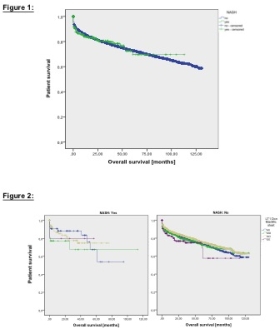Nonalcoholic Steatohepatitis as Indication for Liver Transplantation in Europe. Do We Choose the Right Organs for the Right Recipients?
1Visceral- Transplant, Thoracic Surgery, Innsbruck Medical University, Innsbruck, Austria
2NIHR Biomedical Research Unit and The Centre for Liver Research, University of Birmingham, Birmingham, United Kingdom
3Hepatobiliary Center, Paul Brousse Hospital - Hôpitaux de Paris Université
Paris-Sud, Villejuif, France
4Transplant Surgery, Medical University of Vienna, Vienna, Austria
5Medical Statistics, Innsbruck Medical University, Innsbruck, Austria
6General, Visceral, Transplant Surgery, Charite Berlin, Berlin, Germany
7Liver and Hepato-Pancreato-Biliary Unit, University of Birmingham, Birmingham, United Kingdom.
Meeting: 2015 American Transplant Congress
Abstract number: C117
Keywords: Alcohol, Allocation, Liver transplantation, Risk factors
Session Information
Session Name: Poster Session C: Liver Donation and Allocation
Session Type: Poster Session
Date: Monday, May 4, 2015
Session Time: 5:30pm-6:30pm
 Presentation Time: 5:30pm-6:30pm
Presentation Time: 5:30pm-6:30pm
Location: Exhibit Hall E
Background:
Nonalcoholic steatohepatitis (NASH) has emerged to become the third leading cause for liver transplantation (LT) in the US and since 2002, it has increased constantly.
Methods:
We analyzed the European dataset of over 37.000 adult liver transplant recipients in collaboration with the ELTR (France), including the years 2002 until 2012.
Results:
From 2002 to 2012, 37.612 adult patients underwent LT in Europe. The male percentage accounted for 73.7% (27727/37612), female patients were only 26.1% (9855/37612). The most common indication for LT was alcoholic cirrhosis with 39.8% (14956/37612), the incidence of NASH was documented with 0.9% (337/37612). The overall survival was not different between the NASH group and the other indications (p = 0.681; Fig1). BMI over 40 did not impact on the outcome in the NASH group, but was a significant risk factor in the nonNASH cohort. Donor steatosis stratified as steatosis to mild, moderate and severe did not impact the outcome in the NASH group whereas in the nonNASH patients the difference was significant (p=0,011, Fig2).
Conclusion:
Patients, who underwent LT due to NASH, did not have decreased survival rates when compared to other indications. Severe donor steatosis seems to have no influence on the survival outcome within the NASH group. Should we consider providing NASH patients with donor grafts regardless to their steatosis level that might diminish the gap between needed organs and their demand?

To cite this abstract in AMA style:
Kern B, Newsome P, Karam V, Adam R, Berlakovich G, Fritz J, Popp W, Feurstein B, Pascher A, Muiesan P, Schneeberger S. Nonalcoholic Steatohepatitis as Indication for Liver Transplantation in Europe. Do We Choose the Right Organs for the Right Recipients? [abstract]. Am J Transplant. 2015; 15 (suppl 3). https://atcmeetingabstracts.com/abstract/nonalcoholic-steatohepatitis-as-indication-for-liver-transplantation-in-europe-do-we-choose-the-right-organs-for-the-right-recipients/. Accessed December 14, 2025.« Back to 2015 American Transplant Congress
